In today’s digital age, where online transactions and e-commerce have become the norm, ensuring the security and authenticity of customer identities has become a top priority for businesses. Financial organizations have to address many challenges to accelerate the digital process. Know Your Customer (KYC) processes have traditionally relied on physical documents and in-person verification, but technological advancements have paved the way for a more efficient and convenient solution. With KYC procedures, banks can easily conduct identification onboarding by accurately verifying customers. Video based KYC is a recent development based on the latest technology in video form. This article will explore video-based KYC and how it helps transform the future of various financial organizations.
What is Video Based KYC?
Video KYC is the face-to-face interaction to verify the customer’s identity. This process relies on video kyc online software, which requires a stable online connection for identification through video calling. KYC process depends on the business workflow and how they are operating. Some organizations use video calling for identification, and kyc agents verify customers during onboarding. The data provided in video based KYC depends upon the needs of different businesses. The following data is typically captured in the KYC process:
- Live Detection
- Selfie Capture
- Documents/ID provided by the Government
- Location Data
Businesses use video KYC in many ways; some of the common strategies are given below:
1. Video Interview
A video interview is an interaction between the user and the KYC agent through a video call. During this video interview, the customer is verified by asking a series of questions, and in return, the kyc agent guides the customer through actions that are designed to help the agent with liveness detection and identity proofing. During the video call, the agent will also request a centered selfie submission. After that, the customer is asked to uphold the document, whatever the company requires, to proceed with the verification process.
2. Automated Video Capture
Automated video capture is the process that is used to capture both the audio and video automatically during the onboarding process. Some businesses record the entire video session, while others only require audio recording during onboarding. This audio and video is recorded for liveness detection and authenticity of the customer. Unlike the video KYC interview, automatic video capture doesn’t require any live agent. It offers a better user experience and makes it easier to scale a smaller business while providing a smooth experience.
Video KYC Process in Banking
The video based KYC (Know Your Customer) process is designed to verify the identity of customers’ face-to-face interaction through video calls. Here is a step-by-step guideline for how video based KYC works:
Step 1: User Registration
The customer begins by registering on the banking platform or website that requires KYC online verification. This registration involves basic information of the user, including their basic information such as full name, address, contact details, etc.
Step 2: Document Upload
After registration, the customer is prompted to upload their identification documents. These documents includes a customer’s ID card, driver’s license, any other acceptable form of identification.
Step 3: Scheduling the Video Call
Once the documents are uploaded, the customer is prompted to schedule a video call with a KYC agent. The platform provides available time slots for the call, allowing the customer to choose a convenient time.
Step 4: Video Call Initiation
The customer initiates the video call online through the platform or app at the scheduled time. The call is typically conducted using secure video identification that ensures the privacy and security of the conversation.
Step 5: KYC Agent Verification
During the video call, a KYC agent connects with the customer and begins the video KYC online verification process. The agent will request the customer to display their identification document in front of the camera to compare it with the information provided during registration.
Step 6: Face Matching
The KYC agent will ask the customer to position their face properly within the camera frame for face matching. This allows the agent to verify that the person on the video call matches the photo on the identification document.
Step 7: Identity Validation Questions
To further validate the customer’s identity, the KYC agent may ask a series of questions related to the customer’s personal information.
Step 8: Confirmation
Once the KYC agent is satisfied with the verification process, the video call ends and the customer’s identity is confirmed. The customer will receive a confirmation message or email stating that their KYC process is complete.
Step 9: Data Storage and Compliance
The business securely stores all video calls and customer data collected during the video KYC process for compliance.
Conclusion
In conclusion, video based KYC is the future of identity verification. This video verification process involves face-to-face interaction between a user and the KYC agent through a video call. With its ease of use, scalability, enhanced security, and regulatory compliance, video KYC is revolutionizing how businesses verify their customers’ identities. As technology continues to advance, video based KYC will undoubtedly become the standard for identity verification in the digital world.

